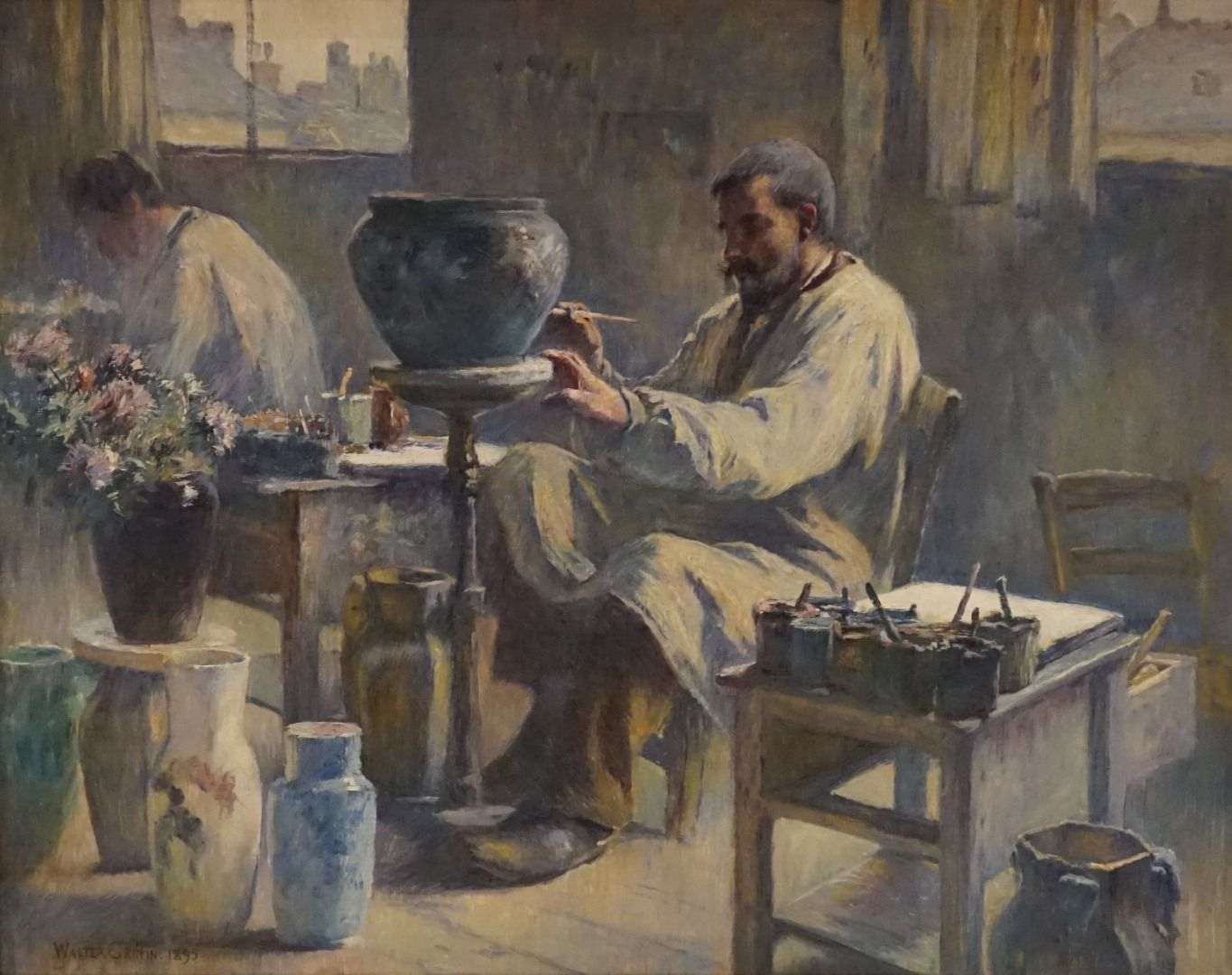Born in Portland, Maine, Walter Parson Shaw Griffin (1861-1935) was an American landscape painter. Griffin studied painting in Boston, and later traveled to Paris, France in both 1910 and 1923 to continue his studies. In Paris, Griffin was taught by prominent painters Louis Raphaël Collin and Jean-Paul Laurens. Griffin also befriended the French painter Jean-François Millet during his travels to the rural villages of Fleury and Fontainebleau. Millet was a founder of the Barbizon school of painters, an artistic movement that is generally seen as a transition between the dominant Romantic movement and the developing Realism movement. Through Millet and his time in rural France, Griffin began to concentrate on landscape painting. Griffin’s European sojourn also allowed him to visit Venice. Like many American Impressionist painters who traveled to Europe, Griffin utilized impasto, the process of thickly applying paint to a surface to impart a dimensional, textured effect, and gestural brushstrokes in his paintings of nature and everyday scenes. Particularly, Griffin was known for his unique painting technique where he loaded his brush with multiple colors, and rather than mixing his colors on a palette, he instead mixed them on the canvas with his brush swipes, expertly combining dexterity with impressionist spontaneity. He typically painted landscapes from his time in France as well as scenes from his beloved birthplace, Maine. Griffin exhibited his works both in the United States and in the competitive Parisian art scene. After traveling and studying in Europe, Griffin moved to Hartford, Connecticut to teach art. In addition to teaching American students, he also opened Walter Griffin’s Summer Painting School in Quebec City, Canada in the late 1890s, teaching students to paint nature directly from nature, or en plein air. During this period, he joined the Old Lyme artist colony in Connecticut, becoming a member of the “Knocker’s Club,” who would criticize—or “knock”—the work of other painters. Griffin joined the Old Lyme colony just as the artist colony embraced Impressionism. While Impressionism is well loved today, it met strong resistance in both Europe and in the United States when it first debuted. Thus, Griffin’s bold adoption of Impressionism and his perfection of his painting technique was avant-garde for its time. The Potter’s Studio is undoubtedly an Impressionist painting, evidenced by Griffin’s gestural application of paint, which captures the natural light pouring into the studio space shared by two potters. While Impressionism often focused on outdoor scenes to best capture the play of color and light, The Potter’s Studio offers a rare look at Griffin’s portrayal of an interior scene. American interest in pottery saw a meteoric rise in the late nineteenth century due in large part to the 1876 Centennial Exposition in Philadelphia. Interest in the exposition’s international examples of pottery and porcelain inspired American potters to create their own works for an eager market. Griffin’s painting presents an inside look at the artisans at work. With a careful hand, the central male figure applies fine details to a ceramic pot sitting on a turntable, which allowed the potter to easily continue his decorating work on the pot’s three-dimensional surface. A vase filled with flowers sits on a pedestal before the potter, likely serving as a reference for the design he paints. Other ornately decorated pots and vases sit on the studio’s floor and to the right rest the potter’s collection of different glazes, divided into separate cups. The potters rely on the natural light flooding in from the upper windows to illuminate their work. Griffin’s use of the windows hints at his more typical subject matter of outdoor spaces. The Potter’s Studio is currently on view in Renegades and Reformers: American Art Pottery.
-Kelli Fisher, Curatorial Intern
Sources:1. Benezit Dictionary of Artists “Griffin, Walter Parson Shaw.” Published October 2011. https://doi-org.libezproxy2.syr.edu/10.1093/benz/9780199773787.article.B00079048.2. Dearinger, David, ed. Painting and Sculpture in the Collection of National Academy of Design, 239-240. Manchester: Hudson Hills Press, 2004.3. Florence Griswold Museum. “The Lyme Art Colony.” Accessed July 7, 2020. https://florencegriswoldmuseum.org/learn/our-history/lyme-art-colony/.4. Florence Griswold Museum. “Walter Griffin.” Accessed July 7, 2020. http://florencegriswoldmuseum.org/collections/online/fox-chase/fox-chase-walter-griffin/.5. Taube, Isabel L. “American Impressionism.” Grove Art Online. 2003; Accessed 8 Jul. 2020. https://doi-org.libezproxy2.syr.edu/10.1093/gao/9781884446054.article.T002327.


